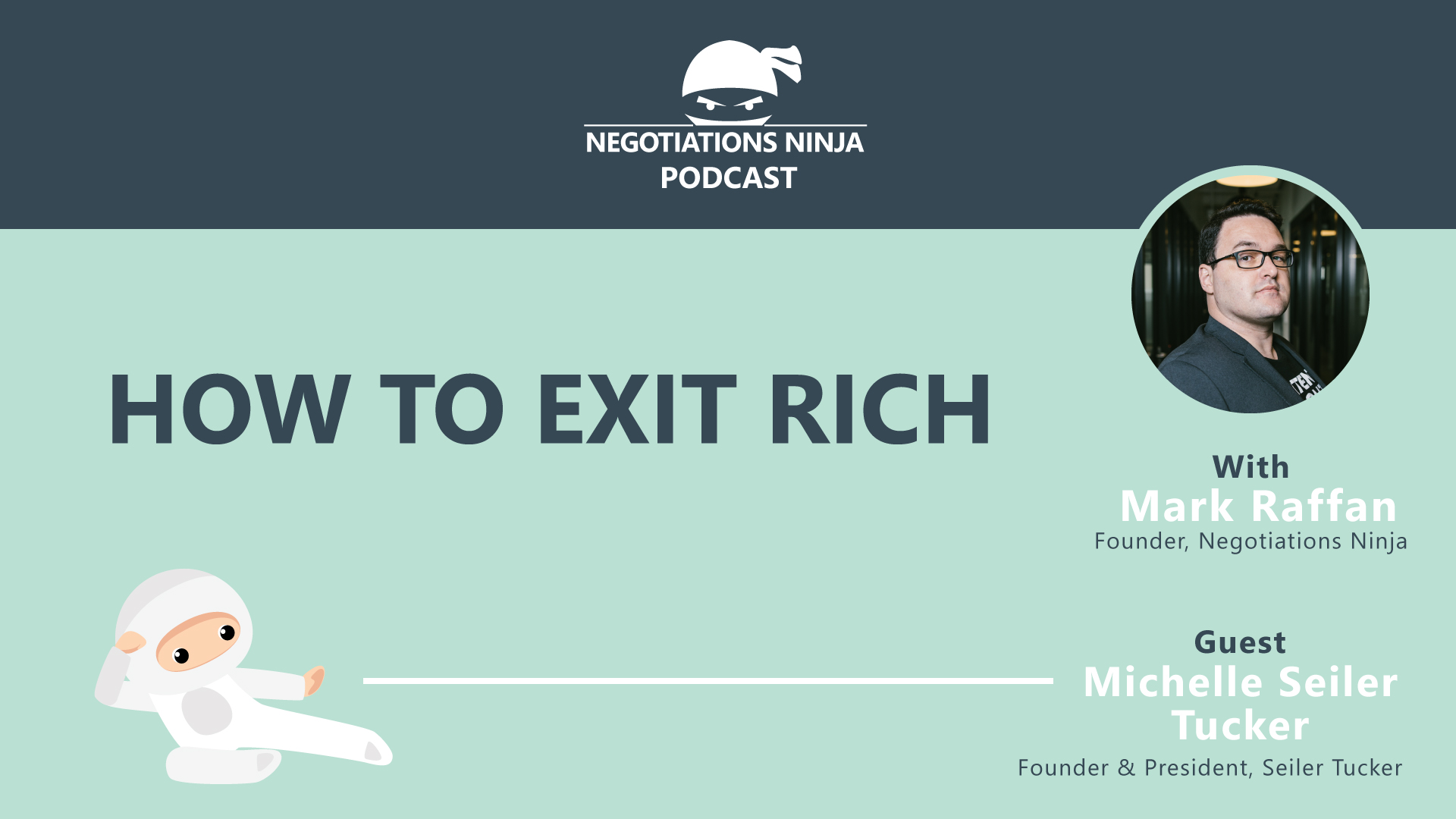The biggest mistake that business owners make is that they don’t plan their exit from their business. People don’t think about the planning and preparation that goes into negotiating the sale of their business. Michelle Seiler Tucker—a mergers and acquisitions master intermediary, a senior business analyst, and the best-selling author of three books—outlines exactly what you need to do to get top dollar for your business in her book, “Exit Rich.” Michelle covers much of that process in this episode of Negotiations Ninja. Don’t miss it!
Outline of This Episode
- [1:55] Who is Michelle Seiler Tucker?
- [3:57] The flip-flop of statistics
- [5:46] Formulating an exit plan
- [7:43] Michelle’s GPS Exit Model
- [12:14] The 6 pillars of proprietary
- [20:31] The 6 P Method to exit rich
- [28:34] How to get Michelle’s book + membership
Start with the end in mind
Why do you need to think about your exit from day one? Michelle shares that when she wrote her first book, she found out that 85–95% of startups fail. The first 1–5 years are the riskiest. When she wrote “Exit Rich,” she learned that the business landscape has flip-flopped. Now, only 30% of startups will go out of business.
However—out of 27.6 million companies—70% of businesses that have been around 10+ years will go out of business. What a shocking number. It’s hard to imagine. 2 million small businesses in the US employ over half the US workforce. If we lose small businesses, we lose jobs. When you lose jobs, you lose spending power. That’s why you need a solid plan from day one.
Your business is your asset—not your baby
Michelle emphasizes that your business is your nest egg—an asset that you’ve worked hard to build. What happens if you can’t sell it? Or even worse, you go out of business?
Business owners have to think about building a business that is valuable that buyers want to pay top-dollar for. Sellers don’t think about selling their business until they have to. Michelle points out that they call her when an internal or external catastrophic event is forcing them out of their business. It could be a death, a health issue, or a partner dispute.
Business owners must think about the business as an asset—not a baby. You don’t build it to sell for yourself; you build it to sell for your heirs. The unexpected does happen, and you don’t want to leave your loved ones with something unsellable.
Michelle’s GPS Exit Model
So, where do you start? Michelle emphasizes that business owners need to follow the GPS exit model: stop driving around in circles and formulate a plan. When you drive somewhere, you use your GPS, right? You start by plugging in your destination. What is your endgame? What is your desired sale price? Start there.
Then you must look at where you’re starting from. What is your current valuation? Michelle was amazed to find out that most business owners have never had their business valuated. That is financial suicide. She emphasizes that you need to be doing yearly checkups on your business. Events will happen that either increase or decrease value (i.e., COVID).
If you want to sell for $20 million and you’re currently at $5 million, you have to reverse engineer a plan to get from A to B. What time frame do you want to sell in? Ten years? After that, you need to determine who your buyers are.
What type of buyers would buy your business? It won’t be a first-time buyer if you want to make $20 million. They can’t afford that. It won’t be a turnaround buyer because they want stressed assets. It will be a private equity group, a competitor, or a serial entrepreneur that chases cashflow.
Now, what is the financial criteria to spend $20 million? Where does your gross revenue need to be? Your EBITDA (earnings before interest, taxes, depreciation, and amortization)? You need $4–5 million in EBITDA unless you’re a SaaS company or have something proprietary. Then you can command a bigger multiple. Average multiples are 1.5–3.5 or 4x. Michelle is careful to point out that the higher the EBITDA, the higher the multiple.
Focus on EBITDA—and synergy
The last step? What characteristics and synergies are they looking to buy? Buyers will pay more for synergy than EBITDA.
What is synergy? Synergy is a benefit that a corporation will realize when they merge with or acquire another company. Facebook paid $19 billion for WhatsApp. WhatsApp was hemorrhaging and certainly wasn’t making any money—but what they did have was 1 billion users. Facebook saw that and knew they could monetize that.
What is Michelle’s 6 P Method to sell your business for a profit and exit rich? What are the pillars of “Proprietary?” Listen to the whole episode to find out!
Connect with Michelle Seiler Tucker
- ExitRichBook.com (Get the book now)
- BOOK: Exit Rich
- Text “Michelle” to 888-526-5750 for more resources
- Michelle’s website
- Connect on LinkedIn
- Follow on Twitter
Connect With Mark
- Follow Negotiations Ninja on Twitter: @NegotiationPod
- Connect with Mark on LinkedIn
- Follow Negotiations Ninja on LinkedIn
- Connect on Instagram: @NegotiationPod




